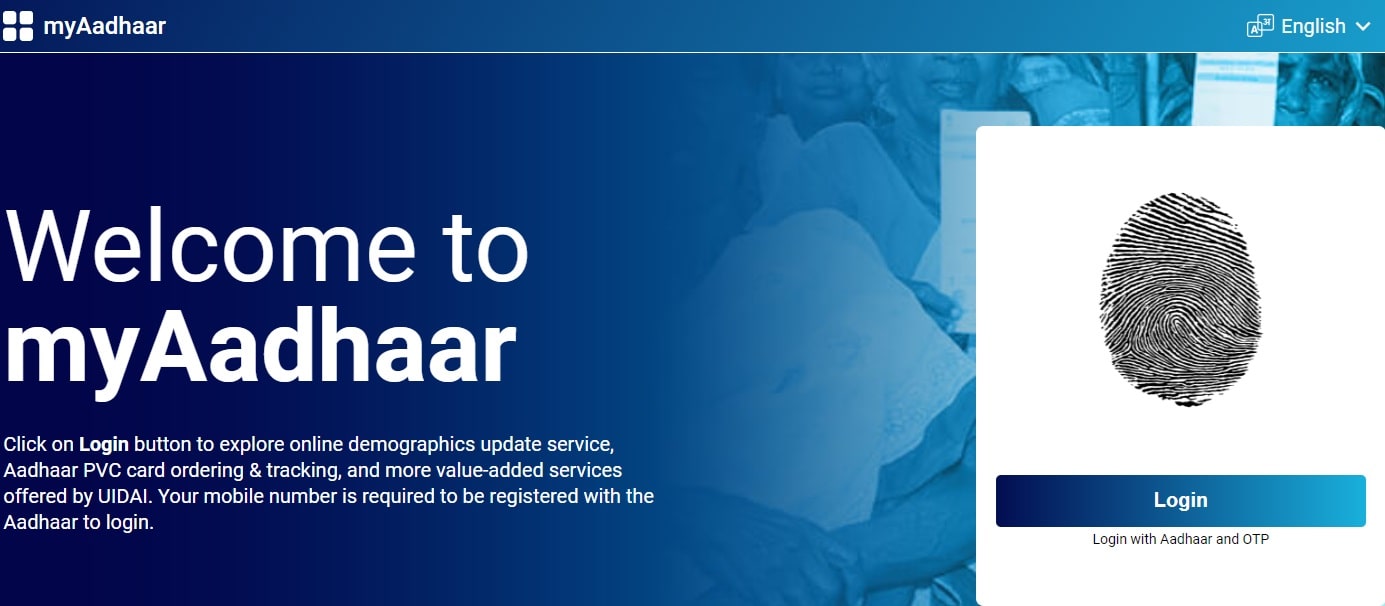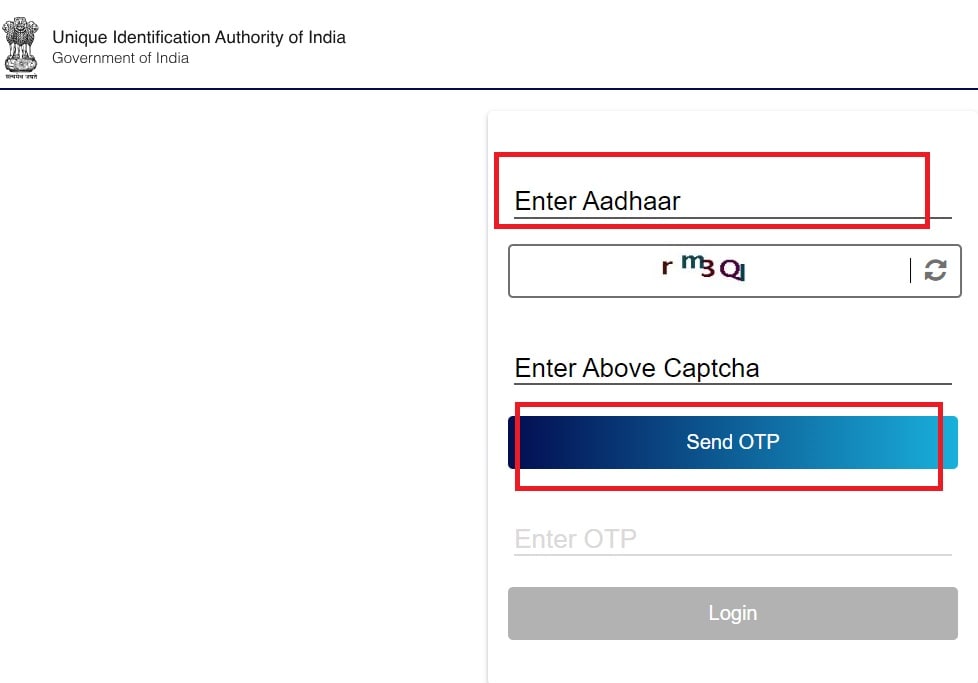UIDAI was established in 2016 under a law called the Aadhaar (Targeted Delivery of Financial and Other Subsidies, Benefits and Services) Act. The Aadhaar number helps identify people correctly and prevents fake identities.
Check all UIDAI and MyAadhaar services-related details here, including UIDAI/Myaadhaar Login, Aadhaar PVC Card Order, Status, and Download, Aadhaar and PAN Link, Aadhaar Update, etc.
UIDAI/Myaadhaar
Most Asked Questions
- How to Link Aadhaar with PAN Card Online?
- How to Update Aadhaar Details Online?
- How to Update UIDAI Mobile Number?
- How to Retrieve Lost EID/Aadhaar Number?
- What are the Documents Required for Aadhaar Card Enrollment and Updates?
- Is It Mandatory to Update Aadhaar Card Details Every 10 Years?
- Is Aadhaar No Longer Valid as Date of Birth Proof by EPFO?
- UIDAI Grievance Redressal Mechanism
- How to Open a Downloaded Aadhaar PDF File?
- How to Update Aadhaar Address Online and Offline?
- How to Generate UIDAI Virtual ID (VID) Online?
- How to File Aadhaar Card Misuse Complaint?
- How Many Times Can We Change Details in Aadhaar Card?
- How to File an Aadhaar Related Complaint Online?
- How to Check Aadhaar Related Complaint Status Online?
- What are the New Rules for Aadhaar Update?
- How to Open Aadhaar Seva Kendra?
UIDAI Login Process
If a person is interested in login in to the UIDAI account and taking advantage of several online facilities available by UIDAI to ease the life of people can follow the steps mentioned below. Here we have provided a step-by-step guide:
To take benefit of several facilities available online related to Aadhaar, first visit the official website of UIDAI which is myaadhaar.uidai.gov.in.

Now, navigate to the login option, available on the main page, and click on it.
It will redirect you to a window where you need to provide your login details which is your Aadhaar Number. After that, enter the captcha code and click on the “Send OTP” option.

Now, an OTP will be sent to the number registered with your Aadhaar Card. Enter the OTP in the “Enter OTP” field and click on the “Login” button.
After following these steps, you can easily log in to your Aadhaar Dashboard from where you can access multiple facilities including bank seeding, PVC order, etc.
Related Articles
FAQs
Aadhaar is a 12-digit unique identity number issued to residents of India based on their biometric and demographic data.
It is obtained through a process of de-duplication using fingerprints, iris scans, and photographs. Each Aadhaar number is randomly generated and cannot be duplicated or reassigned.
No, Aadhaar is not compulsory but residents eligible for it can choose to apply as per the Aadhaar Act. Agencies providing services may require Aadhaar for identification purposes.
Yes, fingerprints, iris scans, and photographs can be updated by visiting an Aadhaar enrolment center.
Yes, date of birth can be updated once in Aadhaar by submitting valid proof of date of birth. A second update requires an exception approval process.
The information regarding fees for Aadhaar updates can be rewritten as follows:
The applicable fees for updation in Aadhaar are as follows:
- Mandatory Biometric Update: Free of cost
- Demographic Update (Any type): Rs. 50/- (Inclusive of GST)
- Biometric Update: Rs. 100/- (Inclusive of GST)
- Biometric with Demographic Update: Rs. 100/- (Including taxes)
- Aadhaar download and color print-out on A4 sheet: Rs. 30/- per Aadhaar (Inclusive of GST)
Please note that when visiting an Aadhaar enrollment center, residents do not have to pay any extra charges for the Aadhaar Enrollment/Correction/Update Form. Additionally, if multiple fields require updating in a single instance, it is considered as one update.
The lost/forgotten Aadhaar number can be retrieved online by visiting the following link: https://myaadhaar.uidai.gov.in/retrieve-eid-uid
Process:
- Select your requirement – Aadhaar/EID you want to retrieve
- Enter full name as in Aadhaar, mobile number/email linked with Aadhaar, and Captcha, followed by OTP
- After mobile OTP-based authentication, the Aadhaar number/EID as per request will be sent through SMS to the linked mobile number.
This service is free of cost.
UIDAI provides multiple options to trace or retrieve your lost/forgotten Aadhaar number, even if your mobile/email ID is not linked with Aadhaar.
Option I: Aadhaar number can be retrieved with the help of an operator at an Aadhaar enrollment center using the “Print Aadhaar” service.
- The Aadhaar number holder should visit an Aadhaar enrollment center in person.
- Provide the 28-digit EID (Enrolment ID) available on the acknowledgment slip (14-digit number followed by the date stamp in the yyyy/mm/dd/hh/mm/ss format) as per the Aadhaar generated enrollment.
- Provide Biometric authentication using a single fingerprint or single iris (RD device).
- If a match is found, the operator will provide a printout of the e-Aadhaar letter.
- The operator can charge Rs. 30/- for providing this service.
Option 2: Aadhaar number can be retrieved with the help of an operator at an Aadhaar enrollment center using the “Print Aadhaar” service.
- The Aadhaar number holder should visit an Aadhaar enrollment center in person.
- Provide the following mandatory information: Name, gender, district or PIN code as per the Aadhaar generated enrollment.
- In case the requirement cannot be traced due to the presence of multiple records, additional available demographic details such as year of birth, C/O, State, etc., may also be provided for narrowing the search.
- Provide Biometric authentication using a single fingerprint or single iris (RD device).
- If a match is found, the operator will provide a printout of the e-Aadhaar letter.
- The operator can charge Rs. 30/- for providing this service.
Option 3: Retrieving a Lost/Forgotten Aadhaar number by calling the UIDAI Helpline number 1947
Stage 1:
- Call 1947 (Toll-free)
- Provide the demographic details required by the executive, as per your request.
- If a match is found, the EID will be provided on the call by the executive. This service is free of cost.
Stage 2 (IVRS):
- Call 1947 again. After selecting the Language option – Key-in option 1 (request status) followed by option 2 (request of Aadhaar enrollment status).
- Provide the available EID number of the Aadhaar generated enrollment to IVRS.
- Provide the Date of Birth and PIN code as per the Aadhaar generated enrollment to IVRS.
- If a match is found, IVRS shall communicate the Aadhaar number. This service is free of cost.
Option I: By visiting an enrollment center
- Visit an Aadhaar enrollment center in person.
- Provide your Aadhaar number or the 28-digit EID (Enrolment ID) available on the acknowledgment slip (14-digit number followed by date stamp in the format yyyy/mm/dd/hh/mm/ss) generated during your Aadhaar enrollment.
- Provide biometric authentication using either a single fingerprint or a single iris scan (RD device).
- If a match is found, the operator will provide you with a printout of the e-Aadhaar letter.
- The operator may charge a fee of Rs. 30/- for providing this service.
Option II: Ordering a PVC card service online
Aadhaar holders can opt for the facility to order a PVC (Polyvinyl Chloride) card service available at https://myaadhaar.uidai.gov.in/genricPVC. The applicant needs to enter their 12-digit Aadhaar number or 28-digit EID and a Captcha. This facility is available for Aadhaar holders, regardless of whether their mobile number is linked to their Aadhaar or not. If the mobile number is linked, the Aadhaar holder will be provided with a provision to track the status of their order by providing the AWB (Airway Bill) number.
Yes, one can enrol for Aadhaar from anywhere in India by providing valid proof of identity and address documents.
Yes, original documents need to be brought to the Aadhaar enrolment center for any updates and will be returned after scanning.
Normally, 90% of update requests are completed within 30 days.
There is no restriction on the number of Aadhaars that can be linked to the same mobile number, but residents are advised to register their own number.
The mobile number cannot be updated online. One must visit an Aadhaar center in person to update the mobile number registered with Aadhaar.
Name, address, date of birth, gender, mobile number, email id, fingerprints, iris scans and photograph can be updated in Aadhaar.
For children below 5 years, no biometrics are captured initially.
They must update fingerprints, iris and photo at 5 and 15 years of age.
No, the charges for Aadhaar services like updates, printouts etc. are uniform across all ASKs as prescribed by UIDAI.
Yes, appointments can be rescheduled or canceled by logging into the appointment portal with the same mobile number/email used for booking.
You will need to first correct the date of birth in either Aadhaar or PAN so that they match, in order to successfully link the two.
If issues persist, you may need to contact the Income Tax department.
For linking Aadhaar and PAN, the name, gender and date of birth should ideally match in both documents. Minor mismatches may require an OTP verification.
For major differences in name, you may need to update details in either Aadhaar or PAN databases first before linking.
The Employees’ Provident Fund Organisation (EPFO) has announced that Aadhaar cards will no longer be accepted as valid proof of date of birth.
In Aadhaar, if you declare your date of birth without documentary evidence, it will be marked as “declared” rather than “verified”.
However, some proof is generally required to update date of birth.
You can visit an Aadhaar enrolment center, provide your Aadhaar number/EID and biometrics, and get a printout of the Aadhaar letter by paying Rs. 30 as fees.
If you were updating your date of birth in Aadhaar for the first time and the request was rejected, you can call the UIDAI helpline 1947 (toll-free) to check the reason for rejection. The executive will guide you on the corrective action required based on the specific reason.
To update your new address in Aadhaar, you need to visit an Aadhaar enrolment/update center with valid proof of your new address document.
The demographic update charge of Rs. 50 (inclusive of taxes) is applicable for address change.
No, updating your registered mobile number in Aadhaar cannot be done online.
You need to visit an Aadhaar Seva Kendra (ASK) or Aadhaar Enrolment/Update Center in person and provide your biometrics to update the mobile number linked to your Aadhaar.
Yes, if your Aadhaar was enrolled as a minor (below 5 years age), you need to update your biometrics (fingerprints, iris scan, photograph) once you attain the ages of 5 and 15 years. This is because children’s biometrics change as they grow up.
An Aadhaar number, once issued, has no expiry date and is valid for life.
However, residents are required to update their biometrics and photograph at a certain schedule to ensure updated records in the UIDAI database.
No, you cannot update details in someone else’s Aadhaar on their behalf. All Aadhaar updates require the concerned individual to be present in person at the enrolment center and provide their own biometrics for authentication.
All About UIDAI
In a world where identification is important for access to various services, the Unique Identification Authority of India (UIDAI) stands as a beacon of technological innovation and identity management. Established in 2009, UIDAI’s primary objective was to provide every Indian resident with a unique identity number, known as the Aadhaar, aiming to streamline welfare delivery, promote financial inclusion, and enhance governance efficiency.
Aadhaar: The Foundation of UIDAI
At the core of UIDAI’s mission lies the Aadhaar, a 12-digit unique identification number that serves as an important instrument for establishing the identity of individuals across the country. This biometric-based identity system encompasses a person’s demographic and biometric information, ensuring accuracy and uniqueness in identification. The Aadhaar number is linked to various services, acting as a universal proof of identity and residence.
Key Components and Technologies
Key components of UIDAI/Aadhaar are:
Enrollment Process:
The process of Aadhaar enrollment involves collecting an individual’s biometric and demographic data, including fingerprints, iris scans, and personal information. This data is then stored securely in the Central Identities Data Repository (CIDR).
Central Identities Data Repository (CIDR):
The CIDR serves as a secure and centralized database housing the biometric and demographic information of Aadhaar holders. It ensures the confidentiality, security, and integrity of the stored data, employing robust encryption and security protocols to safeguard the information.
Aadhaar Authentication:
One of UIDAI’s significant functionalities is Aadhaar authentication, which allows service providers to verify an individual’s identity in real-time by matching their biometric or demographic data with the information stored in the CIDR.
Aadhaar-enabled Payment System (AEPS):
The AEPS facilitates financial transactions using Aadhaar authentication, enabling individuals to access banking services through micro-ATMs using their Aadhaar number and biometric authentication.
Impact and Benefits
Major impacts and benefits of Aadhaar implication are:
Inclusive Access to Services:
Aadhaar has played a pivotal role in enabling marginalized sections of society to access various government services, subsidies, and welfare programs more efficiently. It has streamlined the distribution of benefits, reducing leakages and ensuring that the intended beneficiaries receive their entitlements.
Financial Inclusion:
Through AEPS and Aadhaar-linked bank accounts, UIDAI has contributed significantly to expanding financial inclusion. It has empowered individuals in rural and remote areas by providing them with access to formal banking services.
Enhanced Governance:
UIDAI’s Aadhaar-based authentication has improved the efficiency and transparency of governance. It has facilitated direct benefit transfers, reducing bureaucratic hurdles and ensuring that government subsidies reach the intended recipients.
Privacy and Security Measures
A few important privacy and security-related measures of this implementation are:
Privacy Protection:
UIDAI prioritizes the protection of individuals’ privacy and data security. Stringent measures, including encryption, multi-layered authentication, and regular security audits, are in place to safeguard Aadhaar data against unauthorized access or misuse.
Legal Framework:
The Aadhaar Act of 2016 establishes the legal framework for Aadhaar authentication and data protection. It delineates the permissible uses of Aadhaar data, ensuring its usage complies with privacy norms and safeguards against potential misuse.
Challenges and Controversies
Challenges related to this initiative are:
Privacy Concerns:
Despite stringent security measures, Aadhaar has faced criticism regarding potential privacy breaches. Concerns have been raised about the collection and storage of biometric data, necessitating ongoing efforts to address these apprehensions.
Security Vulnerabilities:
Like any large-scale database, CIDR faces the risk of cyber threats and breaches. UIDAI continually fortifies its security measures to stay ahead of evolving cyber threats and ensure the integrity of Aadhaar data.
Legal Challenges:
The Aadhaar project has encountered legal challenges questioning its constitutionality and the extent of its mandatory usage. The Supreme Court of India has addressed some of these concerns, emphasizing the importance of data protection and privacy.
Future Prospects
A few important future prospects of this initiative are:
Technological Advancements:
UIDAI continues to explore technological advancements, such as AI-based authentication and blockchain integration, to enhance the security and efficiency of Aadhaar services.
Expansion of Services:
The Aadhaar ecosystem is evolving to encompass more services and sectors, aiming to further simplify processes and enable a more seamless experience for individuals and service providers.
Global Collaboration:
UIDAI’s expertise in identity management and biometric authentication has garnered international attention. Collaboration and knowledge sharing with other countries could pave the way for global best practices in identity authentication.
Ethical Considerations
A few important ethical dilemmas that need to be considered are:
Ethical Use of Data:
As UIDAI expands its services and collaborations, maintaining ethical standards in the collection, storage, and use of data remains paramount. Ensuring consent and transparency in data usage is crucial to upholding individuals’ rights and privacy.
Addressing Vulnerabilities:
Constant vigilance and proactive measures to address potential vulnerabilities in the Aadhaar system are essential. Regular audits, updates to security protocols, and ethical hacking exercises help identify and rectify weaknesses.
Public Perception and Trust
Important public prospects related to this initiative are:
Building Trust:
UIDAI recognizes the importance of public trust in Aadhaar’s credibility. Transparent communication, robust grievance redressal mechanisms, and awareness campaigns play a pivotal role in fostering trust among the populace.
User Education:
Educating users about Aadhaar’s benefits, its secure usage, and their rights regarding data privacy can alleviate misconceptions and enhance confidence in the system.
Continued Evolution
The way forward to this initiative is as follows:
Adaptive Governance:
UIDAI’s ability to adapt to technological advancements and changing needs is crucial. A flexible governance structure that accommodates innovation while upholding security and privacy standards is essential for UIDAI’s continued success.
Collaboration and Innovation:
Collaborations with academia, technology firms, and global entities foster innovation, allowing UIDAI to explore new avenues for enhancing Aadhaar’s functionalities and security.
Final Thoughts
The UIDAI’s journey has been marked by milestones and challenges, yet its commitment to providing a robust identification system remains unwavering. Aadhaar’s impact on governance, financial inclusion, and service delivery serves as a testament to its significance in India’s socio-economic landscape. Upholding privacy, ensuring security, and fostering public trust will be pivotal in UIDAI’s continued efforts to empower individuals and streamline processes through Aadhaar.
As technology advances and global paradigms shift, UIDAI’s role as a pioneer in identity management remains crucial. The journey ahead involves not only overcoming challenges but also embracing innovation responsibly to serve the nation’s diverse populace effectively.
The journey of UIDAI and Aadhaar reflects not just a technological milestone but also a commitment to inclusive development and efficient governance, illustrating the transformative power of technology when wielded responsibly for the greater good.
In conclusion, the UIDAI stands as a testament to India’s pursuit of innovation and inclusivity, forging ahead to create a more secure, accessible, and empowered future for its citizens through Aadhaar.

